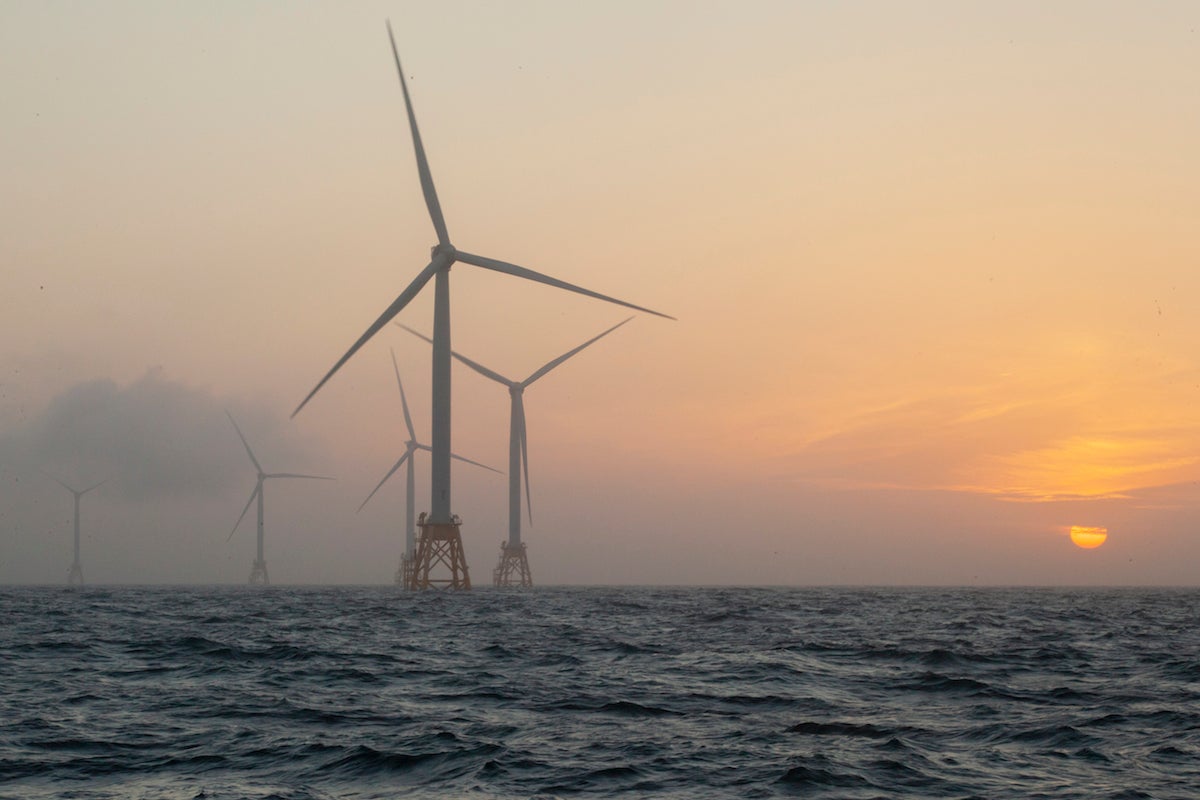KINGSTON, R.I. – Aug. 22, 2023 – The Biden administration has set a goal of deploying enough offshore wind turbines to produce 30 gigawatts—enough to power tens of millions of homes—by 2035. Key to that strategy is the development of floating wind turbines that can be built in vast areas of deeper water.
Backed by a U.S. Department of Energy grant, a team of University of Rhode Island researchers is working with colleagues at the University of Maine to develop a remote sensing and computational system to control the motion of floating wind turbines in irregular ocean conditions. The system would maximize energy production and extend the turbine’s useful life.
The $750,000 grant was provided through the Department of Energy’s Established Program to Stimulate Competitive Research (EPSCoR) program, part of $33 million in awards announced recently to support 14 clean-energy research projects. The URI project began in 2021 with an initial $1.245 million EPSCoR grant.
The vast majority of offshore wind turbines around the world are secured to the seafloor with fixed foundations, such as the turbines off Block Island. The cost of installation of those turbines limits them to coastal waters of up to a depth of about 200 feet. However, floating turbines allow for the use of deep-water areas, which make up two-thirds of America’s offshore wind energy potential, according to a 2022 White House fact sheet.
Stephan Grilli, URI professor of ocean engineering who leads the URI project, says vital to the development of floating wind turbines on a commercial level is the ability to control the movements of turbines to optimize operations. With the grant, URI researchers are developing a wave remote sensing system that combined with real-time control can correct the movement of the turbines in unpredictable seas and high winds, improving power production, reducing fatigue on the structure, and optimizing operations.
“The principle is if the turbine wants to go to one side, you need to have a restoring effect to move it to the other side,” he said. “This is a critical technology that would make large scale deployment of floating wind turbines possible. It’s all about cost. To reduce the cost of energy, you need to reduce the cost of the structure and increase energy production. Active control achieves those two goals.”
The turbines, soaring up to 250 meters above sea level and weighing around 500 tons, sit on floats anchored to the seafloor. They are very top heavy and extremely susceptible to fluctuating waves and other conditions, Grilli said. Wave loading can bend the structure many times, reducing the turbine’s life. Turbulence can also affect the turbine’s blades and reduce energy capture.
The system researchers are working on using LIDAR, a remote sensing method that uses lasers to measure variable distances, to record wave measurements a couple of hundred yards from the turbine. Data are fed to a numerical model, which propagates the wave conditions to the turbine, faster than real time, Grilli said.
A digital twin, which is a computational model of the turbine behavior, predicts the movement of the turbine given the forces from waves and wind, triggering measures to right the structure—such as shifting a solid mass or water ballast, or pulling on the anchors that secure the turbine to the seafloor, or changing the pitch of the turbine’s blades.
With the new two-year grant, URI researchers and their graduate students plan to build and test the LIDAR system, which includes a wave reconstruction and forecasting algorithm. Plans are to first test it in Narragansett Bay. Near the end of the grant, the system will be tested in concert with a 20-meter-tall scale model of a floating turbine at the University of Maine’s field testing facility.
“We’re going to build a floating platform separate from the wind turbine with a computer system that’s going to predict the waves and communicate that to the turbine to see if we can improve control of the turbine’s movements,” he said. “That’s the goal of the new project.”
There are fewer than two dozen floating turbines around the world. But with the lack of sufficient sites suitable for turbines with fixed foundations on both U.S. coasts, floating turbines are needed to reach the president’s goal for wind energy—which includes 15 gigawatts from floating turbines by 2035.
While the West Coast has a narrow continental shelf that forces turbine development to deep water, the East Coast is crowded with many activities—navigation, fisheries and conventional offshore windfarms, Grilli says.
“Once we have installed the approximately 10 farms that are planned or in construction on the East Coast, you’re going to have to move to deeper water,” he said. “Deep water means floating offshore wind turbines.”
In addition to Grilli, URI researchers involved in the project include ocean engineering professors Jason Dahl, Annette Grilli, Reza Hashemi, Brennan Phillips and Bradford Knight. The University of Maine team is led by Richard Kimball, professor of mechanical engineering, and includes professors Babak Hejrati and Kimberly Huguenard.
The project will also help train future workforces for offshore wind and the blue economy. Graduate and undergraduate students were involved in the initial work and will be a part of the new project, Grilli says.
“The blue economy is extremely important for Rhode Island. The state has already demonstrated we were ahead of the curve with Block Island and we are also the staging area for other offshore wind farms,” he said. “In the Department of Ocean Engineering, we want to further develop our expertise in that direction, including our teaching. We are working on a minor in wind energy and are also developing a graduate certificate in offshore wind.”

